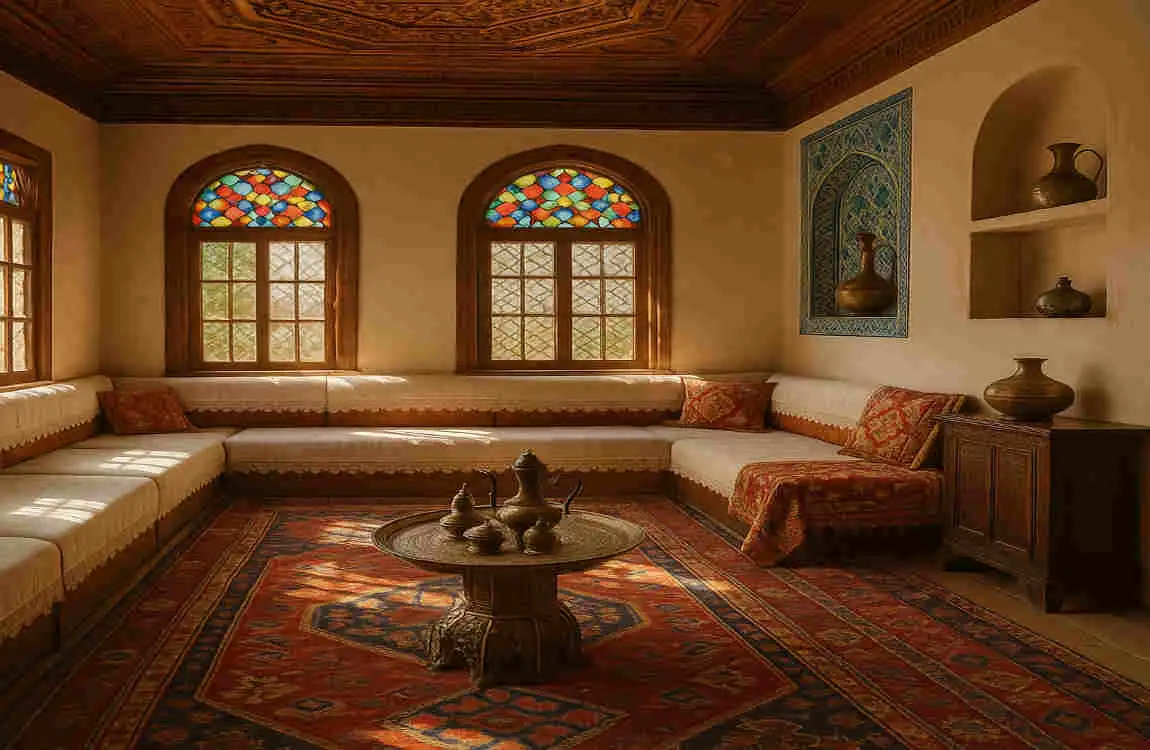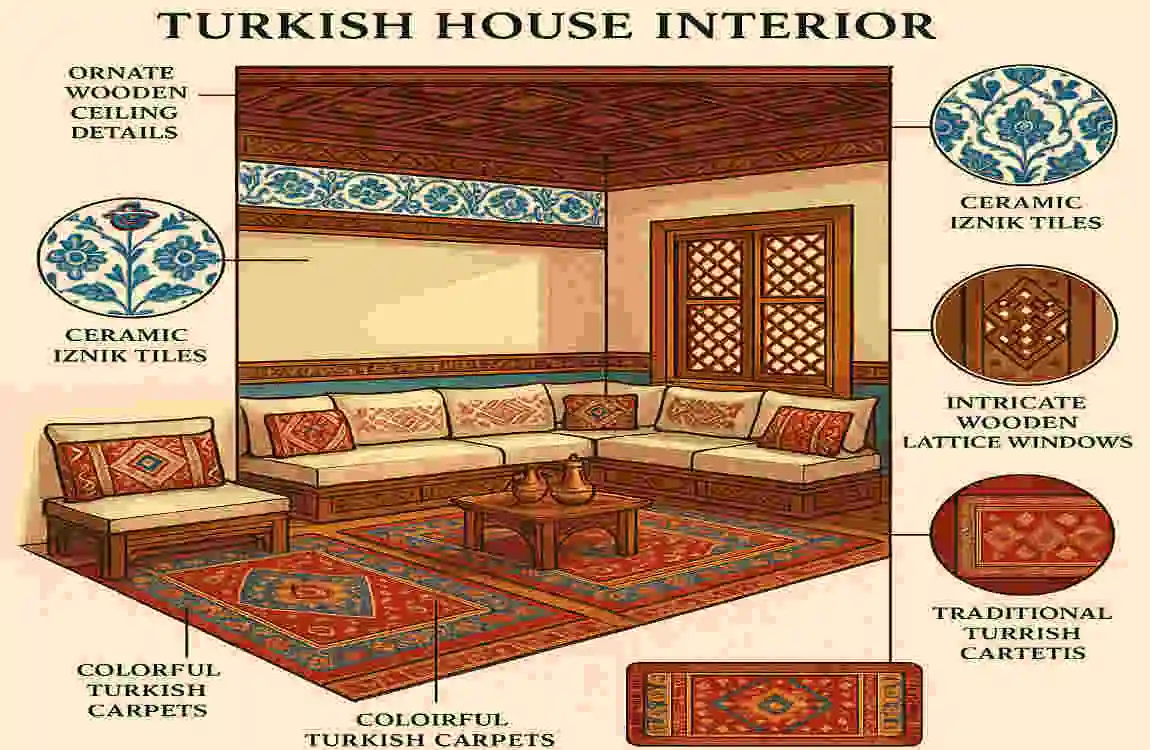Designing a traditional Turkish house interior is like stepping into a rich tapestry of history, culture, and artistry. Turkish interiors are renowned for their unique blend of vibrant colours, intricate patterns, and a deep connection to nature. These elements serve not only an aesthetic purpose, but also reflect the values and traditions of the Turkish people.
Preserving traditional aesthetics while ensuring functionality is essential in modern interior design. This balance allows one to enjoy the beauty of cultural heritage while accommodating contemporary lifestyles.
Understanding the Essence of Traditional Turkish House Interiors

Historical and Cultural Background
The essence of traditional Turkish house interiors is deeply rooted in the country’s history and cultural evolution. Various civilisations, from the Byzantine to the Ottoman Empire, have influenced Turkish architecture. Each period brought its unique touch, contributing to the vibrant and diverse character of Turkish interiors.
Key Themes: Harmony, Comfort, and Connection to Nature
At the heart of Turkish interior design lies the philosophy of harmony. Homes are designed to be inviting and nurturing spaces that foster comfort and relaxation. The use of natural materials and colours creates a soothing environment, connecting the indoors with the beauty of the natural world.
The Philosophy Behind Turkish Interior Design
Turkish interior design emphasises creating spaces that foster social interaction and tranquillity. Traditional layouts often include communal areas that encourage family gatherings, reflecting the importance of community in Turkish culture.
Regional Influences and Architectural Features
Different regions of Turkey exhibit distinct architectural features that influence interior design. For example, homes in coastal areas may incorporate light colours and airy designs, while those in mountainous regions often utilise earthy tones and robust materials like stone and wood.
Key Elements of Traditional Turkish House Interior
Vibrant Colour Palette and Patterns
You may also read (what are the best modern false wall ideas for homes).
One of the most striking features of a traditional Turkish house interior is its vibrant colour palette.
- Warm, Earthy Tones: Colours like terracotta, ochre, and deep greens create a warm and inviting atmosphere.
- Bold Colours in Textiles: Bright reds and blues often adorn textiles, adding life and energy to the space.
- Intricate Patterns: Traditional motifs, including geometric and floral designs, are prevalent in carpets, cushions, and curtains.
These colours and patterns not only enhance the aesthetic appeal but also convey a sense of cultural heritage.
Rich and Luxurious Textiles
Textiles play a crucial role in traditional Turkish homes.
- Hand-Woven Kilims and Rugs: These add cultural significance and warmth to any room.
- Materials Used: Common materials include silk, cotton, and jute, which bring texture and depth to the interiors.
The careful selection of textiles can elevate the overall design, making spaces feel lush and inviting.
Ornate Tiles and Ceramic Art
The art of Turkish ceramics is legendary, particularly the çini tiles.
- Detailed Floral and Geometric Designs: These tiles can be found on walls, floors, and even ceilings, adding artistic elegance.
- Incorporating Tiles: Consider using traditional tiles in modern homes by creating accent walls or using them in kitchens and bathrooms.
Wood and Stone Features
Natural materials, such as wood and stone, are staples in traditional Turkish design.
- Carved Wood Furniture: Exquisite craftsmanship is often seen in furniture and panelling.
- Stone Textures: Incorporating stone in walls and floors enhances rustic charm and provides a tactile experience.
Furniture Style and Layout
Traditional Turkish furniture often features low seating arrangements that encourage social interaction and intimacy.
- Divans and Cushions: These promote a laid-back atmosphere perfect for gatherings.
- Open Floor Plans: A layout that allows for fluid movement and connection between spaces is essential.
Lighting and Ambience
Lighting plays a vital role in setting the ambience.
- Natural Light: Large windows and skylights maximise daylight, making spaces feel airy and bright.
- Traditional Lighting Fixtures: Lanterns and candles add warmth, especially in the evening.
Artistic and Cultural Details
You may also read (grain bin house interior).
Artistic elements can significantly enhance the character of a traditional Turkish home.
- Islamic Calligraphy: This can be incorporated as art pieces, adding a spiritual dimension.
- Hand-Crafted Accessories: Ceramics, metalwork, and local crafts add a personal touch to décor.
Step-by-Step Guide to Designing a Traditional Turkish House Interior

Planning Your Space
The first step in designing your traditional Turkish house interior is to assess the architecture of your home.
- Preserve Traditional Flow: Ensure that the layout maintains an open and inviting flow.
- Select Focal Points: Identify key elements like fireplaces or large windows that can serve as visual anchors.
Choosing the Right Colours and Patterns
Next, consider your colour scheme.
- Consistent Palette: Apply a cohesive colour scheme across textiles and walls.
- Mixing Patterns: Feel free to mix patterns, but do so thoughtfully to avoid overwhelming the space.
Selecting Authentic Materials and Furniture
To maintain authenticity, source materials and furniture carefully.
- Where to Shop: Look for local artisans or reputable online shops that specialise in traditional Turkish décor.
- Balancing Tradition with Comfort: Choose furniture that reflects traditional styles but also provides modern comfort.
Integrating Lighting Elements
Lighting can dramatically affect the mood of your home.
- Maximise Natural Light: Ensure your layout allows for ample natural light.
- Combine Modern and Traditional: Use a mix of traditional lanterns and modern fixtures to create a layered and visually appealing lighting experience.
Adding Decorative and Artistic Touches
Don’t forget to personalise your space.
- Decorative Art: Incorporate calligraphy, ceramics, and handcrafted pieces that resonate with your style.
- Greenery: Adding plants can help bridge the indoor and outdoor environments, enhancing the overall ambience.
Maintaining Balance Between Tradition and Modern Needs
Finally, it’s crucial to find a balance.
- Integrate Modern Amenities: Consider how to include modern conveniences without compromising the traditional feel.
- Cohesive Look: Aim for a design that feels lived-in, warm, and welcoming.
Common Mistakes to Avoid When Designing a Traditional Turkish House Interior
Designing a traditional Turkish house interior can be a rewarding experience, but there are common pitfalls to avoid.
- Overloading on Patterns or Colours: Too many competing elements can create chaos.
- Using Synthetic Materials: Stick to natural materials to maintain authenticity and comfort.
- Neglecting Light and Space: A well-lit space is crucial to highlight the beauty of traditional design.
- Ignoring Cultural Context: Always consider the cultural significance behind your décor choices.
Inspiration and Resources for Traditional Turkish Interior Design
If you’re looking for inspiration or resources to help you design your traditional Turkish house interior, consider these options:
Resource Type Description
Local Artisans: Support your community by purchasing from local craftspeople who specialise in Turkish décor.
Online Shops: Websites like Kikibazaar offer authentic Turkish textiles and artisanal products.
Interior Design Books: Look for books focused on Turkish architecture and design for deeper insights.
Pinterest Boards: Explore visual platforms for curated ideas and inspiration on traditional Turkish interiors.
You may also read (travertine in home design).

